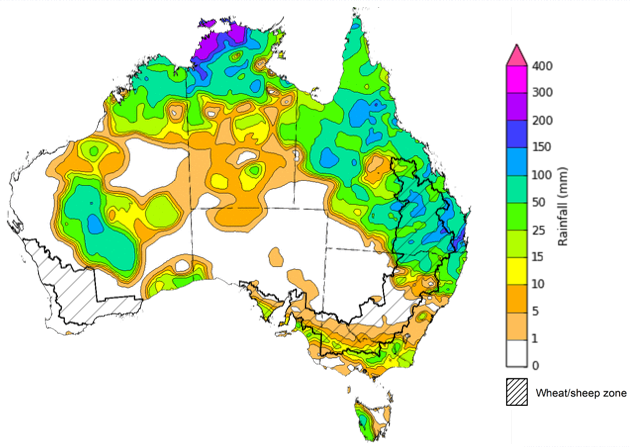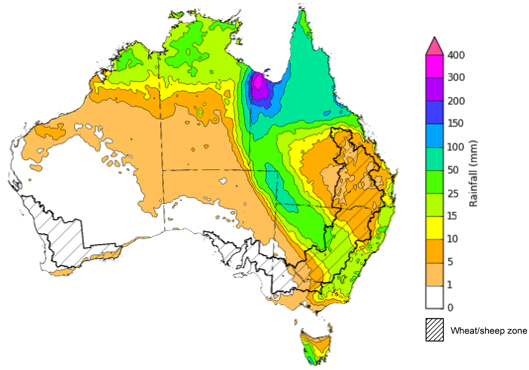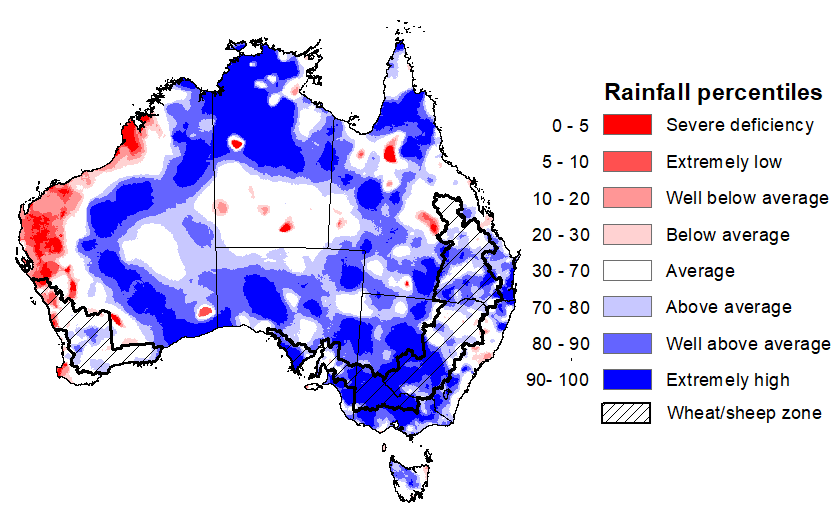Key issues
- In the week ending 31 January 2024 there were storms and heavy rainfall across Queensland and northern areas of Northern Territory and Western Australia. South Australia and much of southern Western Australia were generally dry.
- Over the coming days, the continued movement of Ex Tropical Cyclone Kirrily and troughs are expected to bring rain, showers, and thunderstorms over northern and western parts of Queensland extending into central New South Wales, the Northern Territory and Western Australia.
- Rainfall where expected will support development of summer crops and pasture growth but dry conditions elsewhere, particularly in Western Australia, will continue to see a decline in soil moisture levels. Significant rainfall in autumn will be required in these areas to support the planting of winter crops.
- January rainfall has been above average across Australia, except for along coastal areas in Western Australia and in isolated parts of interior. This has further built-up soil moisture reserves following above average rainfall in December 2023, particularly in the eastern half of the country.
- Water storage levels in the Murray-Darling Basin (MDB) decreased between 25 January 2024 and 1 February 2024 by 133 gigalitres (GL). Current volume of water held in storage is 18 833 GL. This is 13 percent or 2753 GL less than at the same time last year.
- Allocation prices in the Victorian Murray below the Barmah Choke decreased from $62 on 25 January 2024 to $61 on 1 February 2024. Prices are lower in the Murrumbidgee, and regions above the Barmah choke due to the binding of the Murrumbidgee export limit, and the Barmah choke trade constraint.
Climate
For the week ending 31 January 2024, the passage and breakdown of Tropical Cyclone Kirrily brought heavy falls across Queensland. A high-pressure system kept South Australia and much of southern Western Australia generally dry. An active monsoon trough generated storms and heavy falls in northern areas of Northern Territory and Western Australia. Troughs over the interior of Western Australia and in the east brought showers and storms to central Western Australia, northeast New South Wales and southern Queensland. A front and trough brought showers to Victoria, Tasmania, southern South Australia and southeast New South Wales.
Across cropping regions, rainfall totals of up to 200 millimetres were recorded in Queensland, up to 100 millimetres in northern New South Wales, and up to 25 millimetres across parts of Victoria and South Australia. These falls will continue to support the ongoing growth and lift the yield potential of summer crops across eastern Australia. Additionally, these falls will help maintain soil moisture levels to support pasture growth and build reserves ahead of the upcoming winter cropping season. By contrast, Western Australia and much of central to southern New South Wales remained dry.
Rainfall for the week ending 31 January 2024
Issued: 31/01/2024
Note: The rainfall analyses and associated maps utilise data contained in the Bureau of Meteorology climate database, the Australian Data Archive for Meteorology (ADAM). The analyses are initially produced automatically from real-time data with limited quality control. They are intended to provide a general overview of rainfall across Australia as quickly as possible after the observations are received. For further information go to http://www.bom.gov.au/climate/rainfall/
Over the 8 days to 8 February 2024, the continued movement of ex-Tropical Cyclone Kirrily and troughs are expected to bring rain, showers and thunderstorms over northern and western parts of Queensland extending into northern New South Wales, the Northern Territory and Western Australia. Onshore flow is expected to generate showers across coastal New South Wales and northern Victoria.
Across cropping regions, rainfall totals up to 50 millimetres are forecast for central New South Wales. Rainfall up to 10 millimetres is forecast for Queensland, remainder of New South Wales and eastern Victoria. If realised, these falls will continue to benefit soil moisture levels for pasture growth and support summer crops. Little to no rainfall is expected across remaining cropping regions. Western Australian cropping regions continue to experience dry conditions and declining soil moisture levels and will require significant rainfall during autumn to support the planting of winter crops.
Total forecast rainfall for the period 1 February 2024 to 8 February 2024
Issued 02/02/2024
Note: This rainfall forecast is produced from computer models. As the model outputs are not altered by weather forecasters, it is important to check local forecasts and warnings issued by the Bureau of Meteorology.
Rainfall during January 2024 was average to extremely high for much of Australia. The main exceptions were in coastal areas of Western Australia and in isolated parts of interior where it was extremely low. This follows above average December 2023 rainfall across large areas of eastern and south-eastern Australia.
In cropping regions, January rainfall was largely average to above average with exceptions in northern parts of Western Australia where it was below average. Above average rainfall has provided a significant boost to soil moisture levels.
Rainfall percentiles for January 2024
Water
Water storages, water markets and water allocations - current week
The Tableau dashboard may not meet accessibility requirements. For information about the contents of these dashboards contact ABARES.
Commodities
Information on weekly price changes in agricultural commodities is now available at the Weekly commodity price update.
- In the week ending 31 January 2024 there were storms and heavy rainfall across Queensland and northern areas of Northern Territory and Western Australia. South Australia and much of southern Western Australia were generally dry.
- Over the coming days, the continued movement of Ex Tropical Cyclone Kirrily and troughs are expected to bring rain, showers, and thunderstorms over northern and western parts of Queensland extending into central New South Wales, the Northern Territory and Western Australia.
- Rainfall where expected will support development of summer crops and pasture growth but dry conditions elsewhere, particularly in Western Australia, will continue to see a decline in soil moisture levels. Significant rainfall in autumn will be required in these areas to support the planting of winter crops.
- January rainfall has been above average across Australia, except for along coastal areas in Western Australia and in isolated parts of interior. This has further built-up soil moisture reserves following above average rainfall in December 2023, particularly in the eastern half of the country.
- Water storage levels in the Murray-Darling Basin (MDB) decreased between 25 January 2024 and 1 February 2024 by 133 gigalitres (GL). Current volume of water held in storage is 18 833 GL. This is 13 percent or 2753 GL less than at the same time last year.
- Allocation prices in the Victorian Murray below the Barmah Choke decreased from $62 on 25 January 2024 to $61 on 1 February 2024. Prices are lower in the Murrumbidgee, and regions above the Barmah choke due to the binding of the Murrumbidgee export limit, and the Barmah choke trade constraint.



